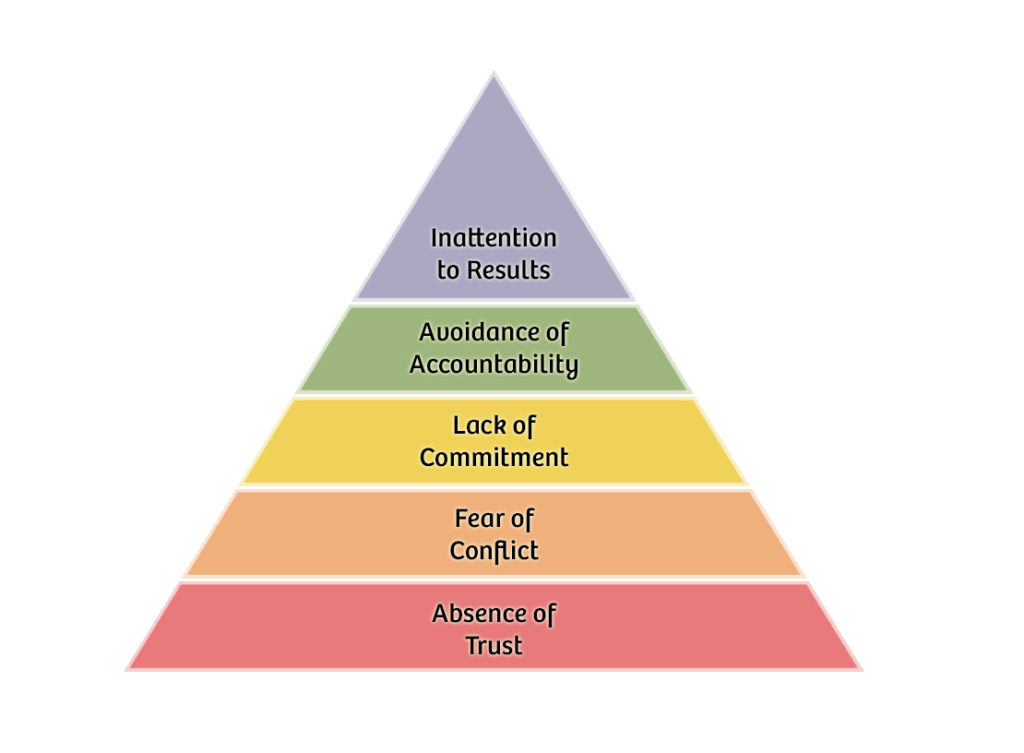What It Is:
The Five Dysfunctions of a Team is a model developed by Patrick Lencioni, an American author and consultant, in his book of the same name. The model identifies common challenges that teams face and provides a framework for addressing and overcoming these dysfunctions.
The Five Dysfunctions:
- Absence of Trust:
- Symptoms: Reluctance to be vulnerable within the group, unwillingness to admit mistakes or weaknesses.
- Impact: Lack of trust undermines team collaboration and transparency.
- Fear of Conflict:
- Symptoms: Artificial harmony, avoidance of difficult conversations, lack of healthy debate.
- Impact: Absence of constructive conflict stifles creativity and prevents the surfacing of diverse perspectives.
- Lack of Commitment:
- Symptoms: Ambiguity around decisions, lack of buy-in, individuals hedging their bets.
- Impact: Without commitment, initiatives lack focus and momentum, hindering progress.
- Avoidance of Accountability:
- Symptoms: Unwillingness to confront peers on performance or behavior, ambiguity about responsibilities.
- Impact: Lack of accountability leads to a decline in team performance and results.
- Inattention to Results:
- Symptoms: Focus on individual goals over team goals, lack of concern for the collective success.
- Impact: Teams that prioritize personal success over shared objectives undermine overall performance.
How to Use It:
Using The Five Dysfunctions in Agile Coaching:
- Team Assessment:
- Utilize the model to assess the current state of the Agile software delivery team. Identify which dysfunctions may be present and hindering effective collaboration.
- Team Building Workshops:
- Conduct workshops to address specific dysfunctions. For example, if there is a lack of trust, engage the team in activities that foster vulnerability and openness.
- Leadership Development:
- Provide coaching for team leaders to enhance their leadership skills. Leaders play a crucial role in creating an environment of trust, encouraging healthy conflict, and fostering accountability.
- Retrospectives:
- Incorporate discussions around the dysfunctions during Agile retrospectives. Encourage team members to openly share their observations and feelings about team dynamics.
Understanding and addressing these dysfunctions can significantly improve team dynamics, collaboration, and overall performance in Agile software delivery. The model provides a structured approach for Agile coaches to diagnose and remedy issues within the team.
References:
- Book by Patrick Lencioni:
- Patrick Lencioni’s book, “The Five Dysfunctions of a Team,” is a valuable resource. It provides a detailed explanation of the model, case studies, and practical strategies for overcoming dysfunctions.
- Team Building Workshops:
- Explore team-building workshops and training programs that incorporate the principles of The Five Dysfunctions. These sessions may provide interactive exercises and tools for application.
- Online Articles and Interviews:
- Lencioni has shared insights about team dysfunctions in various articles and interviews. Online resources can offer additional perspectives and practical tips.
- Leadership Development Programs:
- Leadership development programs often include content on building high-performing teams. Look for resources that draw on The Five Dysfunctions model for guidance.
Visit the Agile Coach’s Toolkit for more definitions, models, theorems and stuff.

